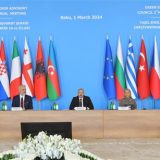The files we follow: Karabakh Conflict Resolution Process, Humanitarian and Security Update in Karabakh and the Lachin Corridor, Abkhazia and South Ossetia / Georgia Conflict, Georgia – EU/ US/Russia/Ukraine Relations and Georgian Domestic Policy, South Caucasian energy, trade and transport issues, Human Rights in South Caucasus, Various foreign policies Armenia, Azerbaijan, Georgia.
Consider subscribing for free access to the full content!
On 19 September at 1:22 p.m., the Azerbaijani Defence Ministry informed about the launch of an anti-terrorist operation to “disarm and ensure the withdrawal of formations of the Armenian armed forces from [their] territories, neutralize their military infrastructure, ensure security of the civilian population […], and finally restore the constitutional order of the Republic of Azerbaijan”. It was specified in the same press release as well as in that of the MAE that the positions of the Armenian army were neutralized using high-precision weapons and that the civilian population and civilian infrastructure were not targeted. The Azerbaijani Ministry of Defence also informed that it had warned the civilian population of the enclave by various means (SMS, loudspeakers, information leaflets) and Report.az published the text of the leaflets distributed.
This decision follows the death of two civilians, employees of the National Motor Roads Agency of Azerbaijan, following the explosion of a mine on the Ahmadbayli – Fizouli – Shusha road and 4 deaths among the employees of the Azerbaijani Interior ministry who subsequently visited the scene of the incident, and who allegedly came across another mine, which Baku described as Armenia’s “deliberate and planned policy of terror”.
For the Armenian Ministry of Foreign Affairs, it is, unsurprisingly, a “policy of ethnic cleansing of Baku […] guided by [a] feeling of impunity” and the term “mass crime” has also been used. The “Nagorno-Karabakh mediator” Gegham Stepanian also spoke of “genocide”. While on the Azerbaijani side, the stated objective is summarized by the following words of Hikmet Hadjiyev, foreign policy advisor to the Azerbaijani presidency: “The illegal separatist puppet regime must be dissolved and the Armenian armed forces stationed in the Karabakh region in Azerbaijan must be disarmed. […] Dissolve and disarm!” An objective reiterated by the presidential administration: “for anti-terrorism measures to stop, illegal Armenian armed groups must raise the white flag, surrender all weapons and the illegal regime must dissolve. Otherwise, anti-terrorism measures will continue to the end.”

This map was created by AB Pictoris
This attack was condemned by a number of international actors: the EU through Toivo Klaar, its special representative for the South Caucasus, Charles Michel, the President of the European Council, or the EEAS; France through its Ministry of Foreign Affairs or the Elysée which appealed to the UN Security Council without a word for the Azerbaijani victims (meeting which should take place on September 21 according to several media), the Germany, the United States through its Secretary of State Antony Blinken.
Russia has adopted a completely different attitude calling for Armenia’s consistency on this issue, through Maria Zakharova, spokesperson for the Russian MFA, in these terms: “The Armenian Ministry of Foreign Affairs calls on the Security Council UN and Russian peacekeeping forces to take steps to end Azerbaijan’s hostilities in Nagorno-Karabakh. But what should we do with Yerevan’s recognition of Nagorno-Karabakh as belonging to Azerbaijan?“, such as those of Dimitri Medvedev, vice president of the Russian Security Council and former president, Margarita Simonian, editor-in-chief of Russia Today, or Dimitri Peskov, Kremlin spokesperson, quoted by Ria Novosti. While the Turkish Foreign Ministry justified the operation in these terms: “legitimate and justified concerns that it has constantly expressed regarding the situation on the ground for almost three years since the end of the Second Karabakh War having not been taken into account, Azerbaijan had to take the measures it considers necessary on its own sovereign territory” as President Recep Tayyip Erdogan at the 78th session of the United Nations General Assembly.
Finally 24 hours after the launch of the operation, an agreement was reached thanks to the mediation of the command of the Russian contingent by both parties, announced by the “Office of the President of Artsakh”, then by the Azerbaijani Ministry of Defence, and including the “withdrawal of the remaining units and military personnel of the Armed Forces of the Republic of Armenia from the zone of deployment of the Russian peacekeeping contingent as well as the dissolution and complete disarmament of the armed formations of Nagorno-Karabakh” while the dialogue proposed by the Azerbaijani side between representatives of the local Armenian population and the Azerbaijani state was accepted and scheduled for 21 September in Yevlakh.
Nikol Pashinian bowed to this decision while reiterating that there had never been an Armenian army in Nagorno-Karabakh since August 2021 and welcoming that the Russian peacekeepers have “fully and now accepted without reserves the entire obligation to ensure the security of the Armenians of Nagorno-Karabakh”. Furthermore, according to him, the objective of the operation was “to involve the Republic of Armenia in military operations” and to aim for “the independence and sovereignty of the Republic of Armenia”. Ilham Aliev, for his part, assured that “the emergence of a new situation in [the] region [was] now inevitable” while promising respect for the rights of the Armenian minority of Azerbaijan and expressing his wish “to build a life together based on peace, mutual understanding and mutual respect”.
This military operation would have caused two civilian deaths on the Azerbaijani side according to the Azerbaijani MFA and at least 200 deaths including 10 civilians and more than 400 injured on the Armenian side according to the “Nagorno-Karabakh ombudsman” which also reported of 10,000 people evacuated (compared to 3154 according to the Russian contingent).






